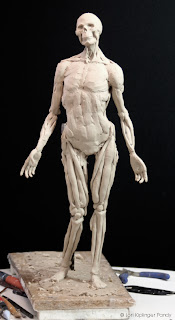
Once the armature was very secure and those feet firmly attached to the
board I began laying in some clay on the wire to create a simple
skeleton framework. A guest to my studio was curious as to why I would
go through the work and trouble to do this as it will all get covered up
later. One major reason is that proper anatomy begins with the bones.
If the bones are wrong, the rest will be wrong too. Placement of major
bony landmarks helps the artist create the forms of the body and by
starting with the basics, you have a firm foundation. It's also much
easier to see and correct problems before you get too far along in the
sculpt.
In this case, I found my problem rather quickly. By using
some of the leg wire to firmly attach the armature to the base (and
allow space for the clay ground upon which she stands) the leg armature
was shortened. Not dramatically for physical accuracy, but as an artist I
can take liberties to create the art as I wish, rather than is average.
In this case, I want my figure to be a more balletic figure of 8.5
heads. By roughing in the bones I immediately detected that the legs
were going to be shorter than my desired length.
A quick check with my proportional calipers confirmed my eye and I set about deciding how much I needed to lengthen my
leg wire. I decided that the best place to add wire is to the femur, as
the upper leg has more muscle and fat. So I cut the wire at the upper
part of the leg and raised the torso bolt up the support pole to create a
gap where I cut the wires. I now had lower legs attached to the board
and the rest of the armature hovering above the lower legs.
Then I
took a smaller gage aluminum wire and cut it longer than the gap
separating the legs. With floral tape, I secured the new wire to the
armature and then wrapped with fine gage copper wire to firmly secure to
existing armature wire.
Once the wire was wrapped, I mixed a two
part epoxy putty and covered the femur - once cured the new armature
area is stronger than the original - the lengthened leg addition is now
exactly what I want and the armature has been altered to meet the needs
of this particular sculpt.
Remember - you can create your own
armatures or make changes to store-bought armatures at any time to suit
your style and tastes.
(Oh - and if you are wondering about the toothpick - that is marking the Suprasternal notch - another useful landmark....)






















































